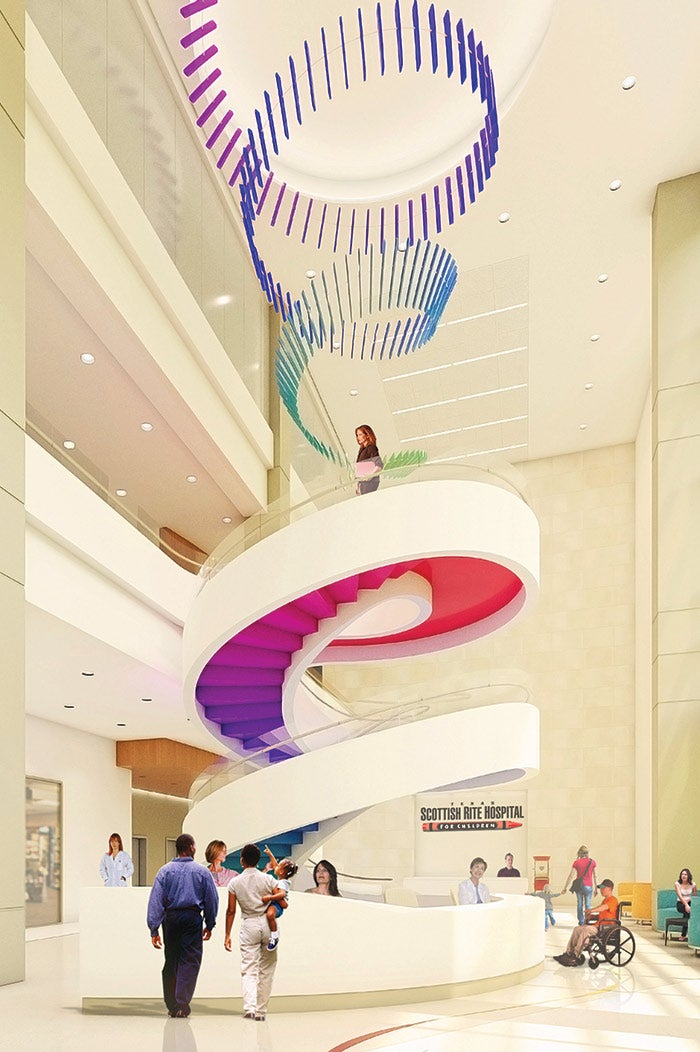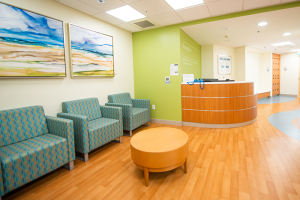How architecture can help progress population health

IThe location of stairs, along with aesthetics, has been shown to increase usage by staff, patients and visitors.
The idea that healthy behavior can be influenced at the population level by altering the environments within which people make choices has gained traction in health care, architecture and policy in recent years.
For example, increasing the time taken for elevator doors to close or the location and design of a stairway in a mall may increase the likelihood of people using the stairs instead. Similarly, doctors and health care providers have begun to intervene in health through strategies like prescriptions for bike share passes to encourage people to exercise more.
These relatively simple behavior-change interventions require little conscious engagement on the part of the individual to realize their intended effects. With time and repetition, others become part of the way an individual goes about day-to-day life. And, across a population, these actions will increase the general health of a group of people.
This suggests that the built environment and those responsible for its design and planning have a role in shaping the health of communities.
Behavioral change
Population health has been defined as “the health outcomes of a group of individuals, including the distribution of such outcomes within the group.” As a concept and a method of measuring health, this includes health outcomes, patterns of health determinants, and policies and interventions that link these two, according to David Kindig, M.D., and Greg Stoddart in their article, “What is Population Health?” in the March 2003 American Journal of Public Health.
Also in this article |
| Hospital's physical transformation helps to revitalize its community |
| Ambulatory center promotes healthful choices |
|
|
The Affordable Care Act’s (ACA’s) main focus is to provide greater access to affordable health insurance, improve the quality of health care and health insurance, regulate the health insurance industry and reduce health care spending. It addresses population health by seeking to expand insurance coverage, improve the quality of the care delivered, enhance prevention and health promotion measures within the health care delivery system, and promote community and population-based activities.
Combined with the ACA, population health will put greater emphasis on overall health and well-being. Systems are incentivized to reduce unnecessary admissions and lengths of stay while providing preventive care so people stay healthy. This shift toward collective health promotion from individualized care reactions has redefined the role of the traditional hospital and the scope of the health care system.
At the core of population health management is behavioral change, which may happen spontaneously or involuntarily without any intervention or systematically through conditioning. Although population health is an encompassing notion, the ambition of improving the health and well-being of all people must begin with defining individual actions. Ten percent of health outcomes are a result of the built environment, while 50 to 60 percent are because of health behaviors, according to an article titled "Achieving Population Health in Accountable Care Organizations" by Karen Hacker and K. Deborah Walker in the July 2013 issue of the American Journal of Public Health. Therefore, improving population health needs to involve altering health behaviors that go beyond the clinical setting and incorporate community and public health systems.
You may also like |
| Managing facilities for population health |
| How community-based care is changing design |
| Eight ambulatory design trends |
|
|
Altering behavior patterns to reduce non-communicable diseases linked to poor diet, lack of physical activity, alcohol consumption and smoking is one of the most important health challenges of the 21st century. Moreover, it is recognized that physical and social environments contribute to these behaviors and that modifying these environments is an important catalyst for change. The term “choice architecture” refers to interventions made across behavioral and environmental contexts to encourage healthy behavior. Health care systems should place an emphasis on taking an active role in the health of their constituents to become wellness campuses versus places for processing the sick.
Building ramifications
With behavior change and choice architecture in mind, population health should be addressed by health care organizations in their approach to building, campus and neighborhood design. On the macro level, people should have equal access to the “timely use of personal health services to achieve the best health outcomes,” according to Sean Stanwick in the article "Making Places, Healing Spaces" on the World Health Design website.
Accessibility to patient care is impacted by a number of factors like health insurance policies, socioeconomic status and geographic location. Poor access to health care has personal and societal costs. If individuals or members of a subpopulation don’t receive proper care or preventive screenings, evaluations or vaccinations, they increase the community’s disease burden. As a best practice, health care facilities should be located, sized and programmed according to the population they serve, which will require understanding and studying health determinants.
In a health-focused market, there will be increased emphasis on reducing stress and improving lifestyle. This translates to a larger number of smaller health care facilities that are located based on community needs and proximity as well as key partnerships among health care, government and community organizations. The main hubs of old markets and aged, centralized facilities will be focused on transforming their assets to be appropriately sized for services that need to be on the hospital campus and reallocating as many services as they can, such as outpatient and preventive care, to satellite sites that are more convenient to the neighborhoods they serve to rekindle healthy communities. This distribution generates opportunities for connecting more at the community scale; for delivering health care in suitable settings; and for transforming practices for the efficient use of resources, supplies and even energy, resulting in improved population health.
This focus on community-centered care enables populations to significantly reduce the incidence of chronic diseases, which will reduce unnecessary inpatient admissions and low-acuity emergency department (ED) visits. As population health management strategies are successful, acute-care facilities are able to be smaller and more efficient while having a higher-acuity component. In the ED, health care facilities are seeing an increase in patient visits with the increase in insured patients. Additionally, there has been a shift to utilize 23-hour observation units as an alternative to admitting patients who may not need to be in an acute care setting, reducing unnecessary inpatient admissions. These shifts again indicate a need to locate these services in the communities that need them most.
Planning tools
In addition to traditional market analytics, there are a number of tools that designers and health care organizations can utilize to assess the needs of the communities served by existing and future projects. For example, in the same way a doctor advises a patient on how to stay healthy, a health impact assessment (HIA) offers advice to designers, clients and communities on making informed choices regarding community design and action to improve public health.
An HIA is defined by the National Research Council as “a systematic process that uses an array of data sources and analytic methods, and considers input from stakeholders to determine the potential effects of a proposed policy, plan, program or project on the health of a population and the distribution of those effects within the population.” The process evaluates potential health effects of a plan, project or policy before it is built or implemented and gives recommendations to optimize positive health outcomes.
A health design assessment (HDA) is another tool that assesses a community’s design needs prior to any proposed policy change or project. HDAs can provide planners and designers with an overview of various planning or design improvement recommendations and strategies that support healthy lifestyles. These tools enable designers to address community-specific population health needs, such as food deserts, walkable communities, fitness needs and community-specific issues. These tools offer opportunities for designers to interact through community outreach with the individuals living in neighborhoods where health care facilities are located to inform design and better connect providers with the communities they serve.
Health systems and designers also have the opportunity to alter the neighborhood and campus environments, blurring the property lines between health care campuses to integrate directly with the community and potentially be a catalyst for renewal, stabilization and growth. The elements that blur these lines also encourage behavior change. To look specifically at physical activity, such as walking, biking and other sporting activities, behavior change can be impacted on a neighborhood or campus scale.
According to “Developing a framework for the assessment of the environmental determinants of walking and cycling” by Terri Pikora, Billie Giles-Corti, Fiona Bull and Rob Donovan in the May 2003 issue of Social Science & Medicine, there are four main factors of the built environment that influence physical activity and impact health and well-being:
- Functional. This includes path attributes such as the type, width, maintenance and continuity of streets; connectivity and traffic routes; intersection design; and other control devices such as traffic signals that may monitor volume, speed and types of traffic.
- Safety. This comprises personal (e.g., adequate lighting) and traffic (e.g., pedestrian and cyclist considerations like proper signage and sufficient crosswalks) components.
- Aesthetic. This includes visually pleasing features such as parks and greenery, natural light, limited pollution, street maintenance and a diversity of well-designed architectural and landscaping elements.
- Destination. This is the availability of local facilities and services (e.g., shops/stores, parks, public transportation and parking) within a community.
As population health changes how hospitals and health systems approach patient care to focus more on health and well-being at a neighborhood and community scale, efforts are being made to break down silos between health providers and community groups. This will enable the creation of districts in which health providers, industry, residential, retail, entertainment and senior living are able to come together to create health care-anchored, mixed-use developments and campuses. These developments are created with the goal of impacting lifestyle to improve health outcomes.
For example, an innovative new community centered on the principles of wellness, prevention and community was recently planned to transform the patient into a health consumer, focusing on daily lifestyle and well-being decisions. Mixed-use and multifaceted, the project fostered a healthy, active lifestyle anchored by health care facilities and linked to culturally significant public environments and entertainment. The project is intended to be a regional destination for people seeking world-class wellness services and entertainment experiences.
The site features an outdoor concert venue; is home to a state-of-the-art-public library facility, a natatorium and an indoor concert venue; and hosts a curated collection of shopping and dining options. Additionally, people are given options within this neighborhood to participate in healthy diet kitchen demonstrations, learn to reduce daily stress with educational sessions offered at the library or exercise at the fitness center with wooded nature trails and integrated rehab facilities, creating an environment for people to live, heal and thrive.
At the micro level of building, design interventions can continue to influence behavior change through choice architecture, both operationally and through the physical building. In fact, research has indicated that using environmental changes such as signs, artwork and music to improve the overall attractiveness of stairwells within buildings can significantly increase the number of people who take the stairs. Additionally, natural light and lobby visibility were found to have positive associations with stair use.
Similarly, changing signage or placing less-healthful foods farther away from customers in a cafeteria may influence the food choices people make.
Implementing programmatic elements into health care facilities, such as patient and community education spaces, libraries, retail, food pharmacies, community gardens and fitness centers that could also be used for rehabilitation have also positively impacted population health. Medical office buildings can be diffused with these community wellness-centered programs to be centers of well-being as much as medical care. Partnerships can be formed between health care organizations and community groups to bring health-focused programs and design elements like community gardens, farmers markets, bike paths, cultural events and education into health care facilities and campuses.
Architectural issue
As the health care field continues to engage with its communities in the era of the ACA, it has become clear that population health management is not only an issue that impacts health care providers, but also is a key issue for architects and designers.
Health and well-being are no longer centered solely on health care facilities, but are shifting into all building typologies. Programs such as the International WELL Building Institute’s WELL Building Standard emphasize that health and wellness should be at the center of design.
Shannon Kraus, FAIA, FACHA, LEED AP, is senior vice president of the board of directors of HKS and Kate Renner, AIA, EDAC, Lean Six Sigma CE, LEED AP BD+C, is an associate at HKS. They can be reached at skraus@hksinc.com and krenner@hksinc.com, respectively.




